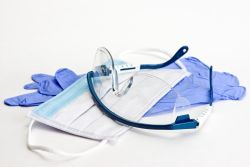Hierarchy of Controls
Administrative Work Practice Controls
Administrative controls are policies and procedures established by management to reduce the risk of exposure to a hazard, such as mercury. Administrative controls include implementing work practices, management policies, and training programs to reduce worker risk.
Administrative controls used to protect workers from exposure to mercury include:
- initial and annual training
- evaluation and maintenance programs
Use a variety of work practice controls to protect healthcare workers from accidental mercury spills.
- Use mercury spill kits to help clean up small spills of 25ml or less. Kits should contain gloves, protective glasses, mercury absorbing powder, mercury sponges, and a disposal bag.
- Put in place procedures to isolate the contaminated area.
- Be aware that mercury can unknowingly be carried home on clothing, skin, or hair.
- Be on the look-out for mercury, recognizing that it may be present in various instruments and equipment.
- Use a Mercury Vapor Analyzer to verify that the area is safe to reenter.
- Make sure that spills are cleaned up promptly and safely by workers or a team trained in proper procedures.
Do not allow workers who are not trained in proper procedures to attempt to clean up spills.
Personal Protective Equipment
The last line of defense against exposure to workplace hazards is personal protective equipment (PPE).
The last line of defense against exposure to workplace hazards is personal protective equipment (PPE). Employers are required to provide appropriate PPE when employees are handling hazardous chemicals, such as mercury [29 CFR 1910.132]. PPE is the least effective control method because it relies on employee behaviors and performance to prevent exposure.
Examples of PPE include:
- coveralls
- booties
- gloves
- face shields
- safety goggles
- respirators
Knowledge Check Choose the best answer for the question.
1-6. Why is personal protective equipment (PPE) considered the least effective control method?
You forgot to answer the question!

